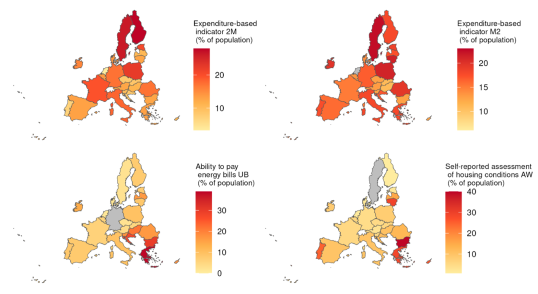Energy is a fundamental human need. Yet tens of millions of EU citizens are struggling to pay their gas and electricity bills. Morgiane Noel considers the EU's 2025 policies to overcome energy poverty in the EU
It might shock you to learn that between 35 and 72 million EU citizens face challenges meeting the cost of their energy bills, as the green transition transforms the energy landscape.
The EU is refining its 2025 energy policies, and energy is emerging as a cornerstone of its social and environmental agenda. The right to energy is laid out in Article 194 of the Treaty on the Functioning of the EU. This Article pledges that every individual deserves affordable, reliable, and sustainable energy access. It also acknowledges that energy poverty exacerbates existing inequalities, disproportionately affecting vulnerable groups such as low-income households, the elderly, and those in rural or disadvantaged areas.
Energy poverty exacerbates existing inequalities, disproportionately affecting vulnerable groups
For the EU, ensuring this right is not only a moral imperative; it is a practical necessity to achieve a just energy transition that leaves no one behind. This commitment aligns with broader EU goals, including the 2019 European Green Deal, which seeks, by 2050, to make Europe the first climate-neutral continent. However, as these ambitious goals reshape energy systems, ensuring affordability and access has become a pressing challenge.
According to Eurostat 2024, 6.9% of EU citizens were unable to warm their house in 2021. In 2022, the figure was 9.3% and in 2023, 10.6%. For more detail, see the European Commission report on energy poverty.
Energy poverty is a reality, experienced at varying levels in different EU countries. In 2024, 30% of the populations of Portugal, Bulgaria, Greece, and Lithuania could not adequately heat their homes. Energy poverty ranged from 10% in the Netherlands and Hungary to over 20% in Sweden, Malta, and Latvia.

The EU has introduced measures to tackle energy poverty and promote sustainable energy access in response to growing energy inequities. Of note are its revisions to the Energy Efficiency Directive (EED), the Renewable Energy Directive (RED), and the Social Climate Fund (SCF).
The EED’s 2025 revisions aim to reduce energy consumption and prioritise support for households experiencing energy hardship.
Under the 2025 Directive, member states must ensure that a significant share of energy savings targets is achieved among low-income and energy-poor households
New provisions include energy-saving obligations, whereby member states must ensure that a significant share of energy savings targets is achieved among low-income and energy-poor households. There is also enhanced data transparency, improved data collection, and reporting mechanisms to better identify and address energy poverty hotspots. Finally, there are building renovation initiatives, with financial and technical assistance in residential buildings, which are among the largest contributors to energy inefficiency.
These measures reduce energy costs for households and contribute to decarbonisation by improving efficiency across sectors.
The Social Climate Fund, introduced in 2021, is expanding its scope to include direct financial support for vulnerable households by the end of the year. Funded programmes include energy-bill subsidies offering households short-term relief. Programmes also include job creation in green sectors, and training to ensure that workers in fossil-fuel-dependent industries can transition to sustainable employment.
Access to affordable renewable energy remains critical. RED’s 2025 updates expand community energy projects, ensuring that vulnerable groups benefit from the green energy transition.
Guaranteeing this right for all EU citizens remains a challenge. Volatile energy markets and the costs of transitioning to renewables continue to drive up prices. While EU policies aim to cushion the impact, many households still face a stark choice between heating their homes and meeting other basic needs.
Energy poverty is not evenly distributed across the EU. Southern and Eastern European countries, where incomes are lower and energy systems often rely on outdated infrastructure, face disproportionate challenges. Tailored policies can address these regional disparities, yet effective implementation varies widely among member states. Insufficient funding, bureaucratic inefficiency, and lack of political will hinder the realisation of EU-level objectives.
To fully realise the right to energy and achieve a just energy transition, the EU must adopt a holistic approach. Greater collaboration and knowledge-sharing enhances the implementation of energy poverty initiatives. The EU must establish a centralised framework to monitor progress, identify best practice, and provide technical support.
While funds like the Social Climate Fund are essential, additional resources must address growing energy poverty. Innovative financing models, such as green bonds or public-private partnerships, could encourage further investments in sustainable solutions. Smart grids, energy storage solutions, and digital energy management tools can all improve efficiency and cut costs.
Financing models, such as green bonds or public-private partnerships, could encourage further investments in sustainable solutions
Ensuring such technologies are accessible to all, including those in remote or neglected areas, is crucial. Community-driven initiatives have proven effective in addressing local energy challenges.
With financial and technical support for energy cooperatives and grassroots projects, the EU can strengthen these efforts. It must integrate energy policy with broader economic measures to address underlying inequalities, aligning energy initiatives with housing, employment, and education policies to create a resilient, equitable society.
The success of the EU’s energy policies hinges on their ability to improve the lives of ordinary citizens. For many, the right to energy is not an abstract concept but a daily struggle to keep their homes warm, their lights on, and their families safe.
However, the right to energy represents a vital intersection of social justice and climate action. As the EU advances its 2025 policies, positioning itself as a global leader in green initiatives, it can set a benchmark for tackling energy poverty while paving the way for a sustainable future. Realising this vision demands bold actions, inclusive policymaking, and a commitment to leaving no one behind in the EU’s energy transition.